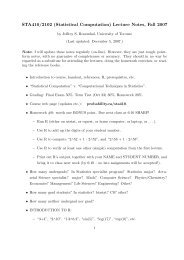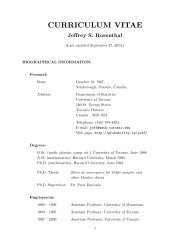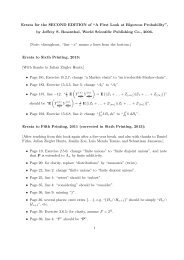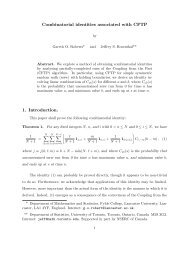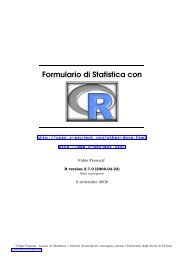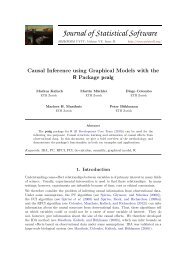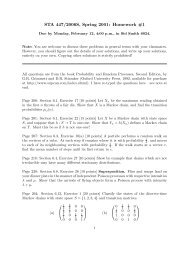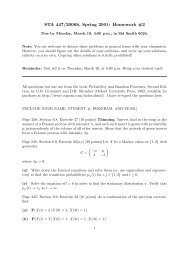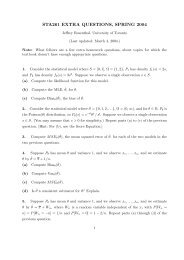final report - probability.ca
final report - probability.ca
final report - probability.ca
Create successful ePaper yourself
Turn your PDF publications into a flip-book with our unique Google optimized e-Paper software.
If one considers a small time increment dt, V t+dt − V t is approximately Gaussian with mean and variance given<br />
by the Euler-Maruyama approximation<br />
V t+dt ≈ V t + b (V t ; θ) dt + σ (V t ; θ) √ dt · Y, Y ∼ N (0, 1) .<br />
Higher order approximations are also available. The exact dynamics of the diffusion process are govern by its<br />
transition density:<br />
p t (v, w; θ) = P [V t ∈ dw|V 0 = v; θ] /dw, t > 0, w, v ∈ R. (3.3)<br />
Suppose that there exists a finite set of observations for the diffusion process above, i.e., one has the collection of<br />
time instances 0 < t 0 < t 1 < · · · < t n with corresponding observations given at v = {V t0 , V t1 , · · · , V tn }. Denote the<br />
time increment between consecutive observations by ∆t i = t i − t i−1 for 1 ≤ i ≤ n.<br />
Then the log-likelihood of the data set v is given by<br />
n∑<br />
(<br />
l (θ|v) = l i (θ) , l i (θ) := log p ∆ti Vti−1 , V ti ; θ ) .<br />
i=1<br />
Unfortunately, other than a few special <strong>ca</strong>ses, (e.g., when the diffusion follows a geometric Brownian motion),<br />
this transition density is rarely available in an analyti<strong>ca</strong>lly tractable form. Hence, deriving maximum likelihood<br />
estimates for generic discretely observed diffusions is a challenging problem. One approach started by Aït-Sahalia<br />
is to expand the transition density using Hermite polynomials. It is shown that this closed-form approximation is<br />
an unbiased estimator of the true (unknown) transition density. A second approach is to use simulation to obtain<br />
the MLE estimates. Exact simulation of diffusion sample paths is a recent approach that is feasible for a wide<br />
class of diffusion processes, although not all diffusions <strong>ca</strong>n be handled by this method. The Exact Algorithm was<br />
introduced by Beskos [BPR06], and it uses technique <strong>ca</strong>lled retrospective sampling.<br />
First it is necessary to apply a variance-stabilization transformation to the diffusion process (3.2). Consider the<br />
Lamperti transform, V s ↦→ η (V s ; θ) = X s ,<br />
η (u; θ) =<br />
ˆ u<br />
1<br />
σ (z; θ) dz.<br />
If σ (·; θ) is continuously differentiable, then we <strong>ca</strong>n apply Itô’s rule to obtained the transformed diffusion’s SDE:<br />
where X 0 = x = η (V 0 ; θ) for s ∈ [0, t], and<br />
dX s = α (X s ; θ) ds + dB s ,<br />
α (u; θ) = b { η −1 (u; θ) ; θ }<br />
σ {η −1 (u; θ) θ; θ} − σ′ { η −1 (u; θ) ; θ } /2, u ∈ R;<br />
η −1 denotes the inverse of the Lamperti transformation, and σ ′ denotes the derivative w.r.t. the space variable.<br />
Assume that α (·; θ) is continuously differentiable, ( α 2 + α ′) (·; θ) is bounded below, and the Girsanov formula for<br />
X, given by<br />
is a martingale w.r.t. Wiener measure. Define<br />
{ˆ t<br />
exp α (ω s ; θ) dω s − 1<br />
0<br />
2<br />
A (u; θ) =<br />
ˆ t<br />
0<br />
ˆ u<br />
α (z; θ) dz<br />
}<br />
α 2 (ω s ; θ) ds ,<br />
to be any anti-derivative of α. Then the transition density of X is defined as<br />
˜p t (x, y; θ) = P [X t ∈ dy|X 0 = x; θ] /dy, t > 0, x, y ∈ R.<br />
Let Q (t,x,y)<br />
θ<br />
denote the distribution of the process X conditioned to start at X 0 = x and finish at X t = y for some<br />
fixed x, y, and W (t,x,y) be the <strong>probability</strong> measure for the corresponding Brownian bridge. The objective of the EA<br />
is to obtain a rejection sampling algorithm to obtain draws from Q (t,x,y)<br />
θ<br />
. The following Proposition provides the<br />
necessary methodology for this. Let N u (0, t) denote the density of a normal random variable with mean zero and<br />
variance t evaluated at u ∈ R.<br />
Proposition 3.1. Under the conditions above, Q (t,x,y)<br />
θ<br />
is absolutely continuous with respect to W (t,x,y) with density:<br />
dQ (t,x,y)<br />
θ<br />
dW = N {<br />
ˆ<br />
y−x (0, t)<br />
t<br />
(t,x,y) ˜p t (x, y; θ) exp 1 (<br />
A (y; θ) − A (x; θ) − α 2 + α ′) }<br />
(ω s ; θ) ds .<br />
2<br />
0<br />
28



